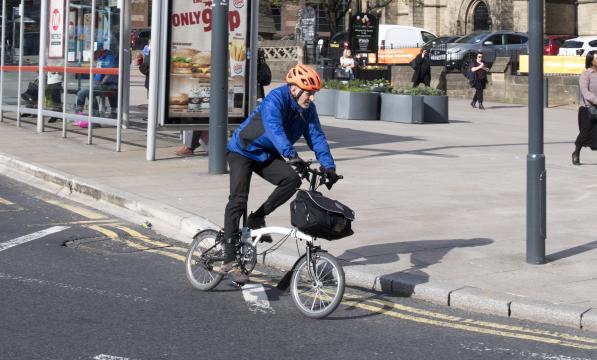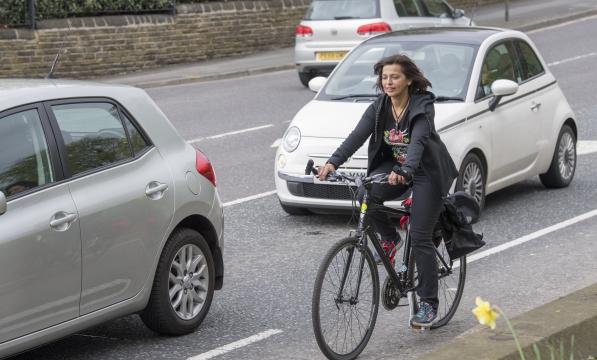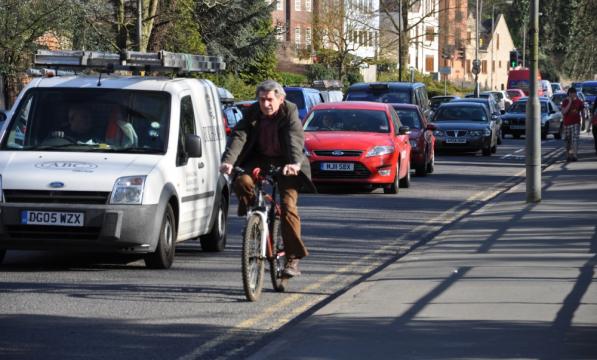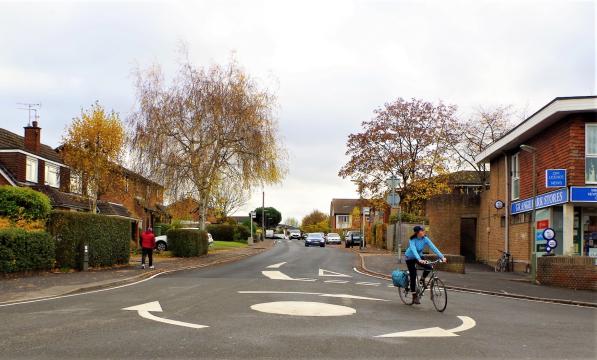How to ensure drivers see you when you are cycling

Kickstarter, GoFundMe and similar crowdfunding websites are awash with gadgets designed to make cyclists more visible.
From the LED-encrusted Holloway gilet by Lumo, as featured on the Apprentice, to the new Visijax jacket plus numerous other gizmos all designed with cyclists’ safety in mind, not to mention the ‘Cyclists Stay Back’ stickers that adorn nearly every bus and lorry these days, the onus is normally put on cyclists to avoid being hit by other road users, rather than educating drivers to look out for them.
While good lights are a must – and are, of course, a legal obligation – and some may go for reflective clothing, there’s more cyclists can do to avoid collisions.
Indeed, relying on drivers to see you, even if you’re lit up like the proverbial Christmas tree, may lure you into a false sense of security. The reality is, although you may feel safe attired in your day-glo fluorescent yellow cycling jacket and matching trousers, with accompanying hi-spec lights, unfortunately some drivers still may not see you.
Remember that awareness test showing people playing basketball and the moonwalking bear? How many people spotted the bear?
Is pavement riding the answer?
So, what’s the solution? Ride on the pavement or footway? Surely that’s safer? No, it’s illegal for a start, unless the path is designated shared use.
It may also be more unwise than you realise. Think about all the hazards that you might encounter: street furniture, dropped kerbs, unlit defects, pedestrians, vehicles emerging from driveways and many more. And yes, many so-called cycle tracks include many of these!

No, the best thing you can do, day or night, is to think about your road positioning and how you interact with other road users – if you interact with them at all, that is. Let’s take a look at some common situations and how you can help protect yourself from the ‘Sorry, mate, I didn’t see you’ scenario.
Passing a side road
Junctions are one of the most common places where drivers may not see you. For a start, they may not be looking for cyclists; secondly, you may be in their ‘blind spot’', and third, they may see you but misjudge how fast you’re going, or may see you but not register your presence.

Long before you reach a turning on the left-hand side of the road, check carefully behind and see if it’s clear. This may not always be so easy on a fast main road, but if you start the manoeuvre in plenty of time, indicating if necessary to get into the flow of vehicles, it can be very effective.
If it’s safe to do so, move further out into the centre of the lane so that if a vehicle is emerging from the side road, you are not in the blind spot. This will make you more visible and also mean there’s more space between you and the front of the vehicle so, if the driver does still pull out, you have a bit more time to take evasive action.
You can also try to make eye contact – if I’m not 100% sure a driver has seen me, I will slow down or even stop rather than risk it. Keeping your fingers on your brake levers will mean you’re ready for this at all times and could buy a few vital seconds.

Don’t worry about vehicles coming up from behind – if they have let you in, they have seen you; if not, and they have appeared after your manoeuvre, they are still much more likely to see you than somebody emerging from a junction. Their inconvenience is a small price to pay for your safety.
But even if they seem impatient, don’t be put off. You are helping the traffic flow more smoothly and also, by making yourself more visible, helping drivers to drive more confidently around you.
Don't forget to check down side roads, driveways and junctions on the other side of the road too.
Passing a parked vehicle

Similarly, when you ride past a parked car you may be invisible to anyone in it who isn’t looking properly. It’s quite hard to see a cyclist coming up beside you if you’re in a parked vehicle.
Don’t rely on being seen. Make sure you’re riding at least a car door’s width away from any vehicles. They may suddenly pull away or even open a door into your path. Watch our Dutch Reach video to see how drivers are taught to open car doors in the Netherlands so that they are less likely to ‘door’ cyclists riding past.
Keep as far away from stationary vehicles as possible (although there may be times when it’s unavoidable, unfortunately). Again, not only will it be easier to see you but you will also be able to interact more easily with drivers in front of and behind you, meaning they will be more likely to give you room.
Look behind regularly to keep an eye on what’s going on and signal your intentions clearly if it’s safe to do so.

Passing slower moving vehicles
You’re riding along enjoying the freedom of the open road when the traffic slows down and you’re stuck behind a row of vehicles at a set of traffic lights or approaching a roundabout. It’s very likely you’ll spot a gap on the inside of the queue and aim for it, especially if there’s a cycle lane marked. But is that where you’ll be most visible?
Drivers may not be expecting anything to pass them on the inside, and passengers may be tempted to hop out without looking behind. It’s better to overtake on the outside of the queue, again leaving as much room as possible, and wait either behind the first car or, if there’s enough space, at the front of the queue.
However, if the first vehicle in the queue is a lorry or HGV, make sure you can make eye contact with the driver as they may not be able to see you just in front of them.

Top tips
- Don’t rely on being seen by drivers, no matter how brightly you’re dressed
- Be proactive – change road position, interact with other road users, ride assertively
- Make eye contact where possible or at least try and gauge whether or not you’ve been seen
- Cover your brakes so you can slow down or stop when approaching junctions or on roundabouts if you are not sure you’ve been seen
- Move out early and create as much space as possible so you can see and be seen
Nothing can replace getting some National Standard cycle training if you want help putting these tips into practice – an hour or two with an instructor can make all the difference and teach you how to negotiate many different kinds of situations. Some local authorities offer this for free, while others may charge a small amount.





